Spatial Distribution Characteristics and Influencing Factors of Hakka Traditional Villages in Fujian, Guangdong, and Jiangxi, China
Abstract
1. Introduction
2. Materials and Methods
2.1. Study Area
2.2. Data Resources
2.2.1. Method of Selection of Hakka Village Listings in Fujian, Guangdong, and Jiangxi
2.2.2. Data Extraction of Influencing Factors
2.3. Analysis Method
2.3.1. Kernel Density Estimation
2.3.2. Nearest Neighbor Index
2.3.3. Superposition Analysis Method
2.3.4. Correlation Matrix Analysis of Dependent Variables
2.3.5. Geodetectors
3. Results
3.1. Distribution Characteristics of Hakka Villages in Fujian, Guangdong, and Jiangxi
Analysis of the Distribution of Hakka Villages in Fujian, Guangdong, and Jiangxi
3.2. Influencing Factors
3.2.1. Elevation Factors
3.2.2. Slope and Slope Orientation
- Slope
- Slope orientation
3.2.3. Distance from Road and Water Systems
- Distance to Land Transportation
- Water System Distance
3.2.4. Vegetation Cover
4. Discussion
4.1. Correlation Matrix of Dependent Variables
4.2. Divergence and Factor Detection
4.3. Interaction Detection
5. Conclusions
Author Contributions
Funding
Informed Consent Statement
Data Availability Statement
Conflicts of Interest
References
- Luo, X. A Study of the Origin and Flow of Hakka; China Overseas Chinese Publishing House: Beijing, China, 1989; Available online: http://book.jxcbelib.superlib.net/views/specific/2929/bookDetail.jsp?dxNumber=000001130847&d=FF69D64243E119D9B6BFE60468B43667&fenlei=08021306 (accessed on 2 March 2022).
- Zheng, L.; Li, Y.; Lu, S.; Bao, J.; Wang, Y.; Zhang, X.; Xue, H.; Rong, W. Physical characteristics of Chinese Hakka. Sci. China-Life Sci. 2013, 56, 541–551. [Google Scholar] [CrossRef]
- Lin, C.M.; Zhong, T.Y.; Liu, S.Q.; Zhong, Y.; Liu, L.P.; Lai, W.H.; Chen, X.Y.; Li, H.L. Analysis and prevention of gene mutation types of severe thalassemia in Hakka people in Gannan of Jiangxi Province. Exp. Hematol. 2020, 28, 2017–2021. [Google Scholar] [CrossRef]
- Chang, C.C. Hakka genealogical migration analysis enhancement using big data on library services. Libr. Hi Tech 2018, 36, 426–442. [Google Scholar] [CrossRef]
- Hua, L.; Chen, C.; Fang, H.; Wang, X. 3D documentation on Chinese Hakka Tulou and internet-based virtual experience for cultural tourism: A case study of Yongding County, Fujian. J. Cult. Herit. 2018, 29, 173–179. [Google Scholar] [CrossRef]
- Mu, Z.Y.; Yan, L. Study on the collection, arrangement and utilization of agricultural cultural heritage of Gannan Hakka. J. Ethnic Cult. 2020, 12, 110–116. [Google Scholar]
- Tao, J.; Chen, H.; Xiao, D. Influences of the natural environment on traditional settlement patterns: A case study of Hakka traditional settlements in eastern Guangdong Province. J. Asian Archit. Build. Eng. 2017, 16, 9–14. [Google Scholar] [CrossRef]
- Chen, L.Y.; Lian, W.H.; Bian, H. Analysis on the spatial distribution and origin of Hakka place-name cultural landscape. Sci. Surv. Mapp. 2019, 44, 70–77. Available online: https://kns.cnki.net/kcms/detail/detail.aspx?dbcode=CJFD&dbname=CJFDLAST2019&filename=CHKD201903012&uniplatform=NZKPT&v=pupJ1Yu0U28Sc5HpGsQxr5e9MYA_j6dQA-08fHGogyvbILTDFnP2rf_wKD7lj5sE (accessed on 23 June 2022).
- Li, J.W. The cultivation of ethics and morality in the ancient Hakka ancestral halls of Meizhou. Arch. Soc. 2017, 156–158. [Google Scholar]
- Liu, D. The beliefs of King Min in the Hakka region of western Fujian. Fujian Trib. (Human. Soc. Sci. Mon.) 2017, 10, 117–124. [Google Scholar]
- Yan, S.H. The Hakka dialect in the perspective of ethnic identity. Jiangxi Soc. Sci. 2019, 39, 239–244. [Google Scholar]
- Zhuang, C.S. The classification and development of nominal suffixes -zi (子) and -zai (崽) in Hakka dialects. Stud. Chin. Lang. 2020, 1, 66–76+127. [Google Scholar]
- Lee, W.S.; Zee, E. Hakka Chinese. J. Int. Phon. Assoc. 2009, 39, 107–111. [Google Scholar] [CrossRef]
- Chang, C.C.; Liao, C.H. Developing a context-aware annotation system for Hakka culture-specific language learning. Libr. Hi Tech 2017, 35, 445–457. [Google Scholar] [CrossRef]
- Zhang, X.; Lai, D.M. Investigation and reflection on the survival status of Fujian Hakka opera troupes. Chin. Theatre 2020, 4, 90–91. Available online: https://kns.cnki.net/kcms/detail/detail.aspx?dbcode=CJFD&dbname=CJFDLAST2020&filename=XIJU202004037&uniplatform=NZKPT&v=p-wSkOsM2G-ZI_Vdw8npXzc0knmd3k7cIlHdAo1dzPyTfDLckggxXoEJhmf6QR31 (accessed on 2 March 2022).
- Wang, S. The hundred-year vigil of the Hakka string puppet show in Liancheng. West. Fujian Chin. Theatre 2019, 8, 90–91. Available online: https://kns.cnki.net/kcms/detail/detail.aspx?dbcode=CJFD&dbname=CJFDLAST2019&filename=XIJU201908035&uniplatform=NZKPT&v=hdZ8CmHGGifZJmkrvueIuav1bmtLbDYDJ3yGRA7rnxoXY8gCkAGSBzFZ4Isl1WQ7 (accessed on 2 March 2022).
- Liu, Y.J.; Chen, D.S. Research on embroidery patterns of Hakka’s traditional costumes. J. Textile Res. 2012, 33, 114–117. Available online: https://kns.cnki.net/kcms/detail/detail.aspx?dbcode=CJFD&dbname=CJFD2012&filename=FZXB201207024&uniplatform=NZKPT&v=ejrQ25eskdFCW9Ujw3Ut1cFxbfsY8UEzwY-6T0naYu47KlIfBOsJnCOmjxRoE8GE (accessed on 24 June 2022).
- Xiao, Y.S.; Mei, Q. An investigation of the historical value of Hakka earth buildings in Bayu Area: The case study of Qu’s building in Dashun, Fuling, Chongqing. Reg. Archit. Cult. 2021, 246–247. Available online: https://kns.cnki.net/kcms/detail/detail.aspx?dbcode=CJFD&dbname=CJFDLAST2021&filename=JZYW202110094&uniplatform=NZKPT&v=qSZIZKyJ9zmhhduBwBg_zbkjWp91QOPRmEIL8oC0eoCVUTQDMiHtY7tiQKQzrFOf (accessed on 1 March 2022).
- Jiang, F. Ganan Guanxi Xinwei architecture and culture. Archit. Cult. 2020, 36, 173–174. [Google Scholar]
- Lowe, K.D. Heaven and earth-sustaining elements in Hakka Tulou. Sustainability 2012, 4, 2795–2802. [Google Scholar] [CrossRef]
- Luo, Y.; Yin, B.; Peng, X.; Xu, Y.; Zhang, L. Wind-rain erosion of Fujian Tulou Hakka earth buildings. Sust. Cities Soc. 2019, 50, 101666. [Google Scholar] [CrossRef]
- Ueda, M. A preliminary environmental assessment for the preservation and restoration of Fujian Hakka Tulou complexes. Sustainability 2012, 4, 2803–2817. [Google Scholar] [CrossRef]
- Zhuo, X.L.; Xaio, D. A study on the development logic of the morphotype of Hakka vernacular residence and its geo-spatial distribution patten in the border area of Jiangxi, Fujian, and Guangdong based on a novel method of universal survey. Archit. J. 2020, S2, 16–22. Available online: https://kns.cnki.net/kcms/detail/detail.aspx?dbcode=CJFD&dbname=CJFDLAST2020&filename=JZXB2020S2003&uniplatform=NZKPT&v=o0Oc0K45_RkEM3Rs0ocilDVoftLAlfLwMmO388vrkrPZE5olnbVsBxocYCyQHaMi (accessed on 2 March 2022).
- Pan, Y.; Cai, M.F.; Shi, Y. The analysis of the characteristics of traditional settlement landscape of Hainan lsland ethnic group based on language zone. Chin. Landsc. Archit. 2020, 36, 41–46. Available online: https://kns.cnki.net/kcms/detail/detail.aspx?dbcode=CJFD&dbname=CJFDLAST2021&filename=ZGYL202012008&uniplatform=NZKPT&v=Lj31kjFcyFsb1werRMq92KFC1W8tjWOAj4-e28cy8BoRuUBv6zjJaTAhdr2-TGTd (accessed on 2 March 2022).
- Liu, P.L.; Liu, C.L.; Deng, Y.Y.; Shen, X.Y.; Hu, Z.; Li, B.H. Study on the identification of Hakka traditional village’ s land-scape genes and analysis in the perspective of geography. Hum. Geogr. J. 2009, 24, 40–43. Available online: https://kns.cnki.net/kcms/detail/detail.aspx?dbcode=CJFD&dbname=CJFD2009&filename=RWDL200906012&uniplatform=NZKPT&v=o9wDQJYBUHp-nbGxsZVrI2yILL9_CTL-rKMSFQhpySk5QgNi5GDqOHnI2wdb0kwU (accessed on 2 March 2022).
- Wang, S. Experience of Hakka earth buildings to deal with water environment in mountainous areas. J. FuJian Univ. Technol. 2021, 19, 453–457. [Google Scholar]
- Wang, X.Q.; Liu, C.Q.; Jin, J.H. Research on the morphological characteristics and influencing factors of public space around Hakka villages in Southern Jiangxi Province: Case study of Li Yuen Wai in Jiangxi Province. Art Design 2019, 7, 108–111. [Google Scholar] [CrossRef]
- Zhang, L. Space types and deep structure of the Bailu ancient village in Ganxian County. J. Guangxi Univ.National. 2017, 39, 73–82. [Google Scholar]
- He, Y.; Chen, C.P.; Chou, R.J.; Luo, H.; Hou, J.S. Exploring the transformation in the “Spirit of Place” by considering the changed and unchanged defensive spaces of settlements: A case study of the Wugoushui Hakka settlement. Land 2021, 10, 490. [Google Scholar] [CrossRef]
- Liang, B.Q.; Ziao, D.W.; Tao, J.; Ji, J.J.; Zhuo, X.L.; Huang, Y. Spatiotemporal distribution and evolution of Hakka traditional villages in Ganzhou. Econ. Geogr. 2018, 38, 196–203. [Google Scholar] [CrossRef]
- Sun, Y.; Wang, Y.S.; Xiao, D.W.; Zhang, Q.B. The spatial distribution and evolution of Hakka traditional villages on GIS in Meizhou area. Econ. Geogr. 2016, 36, 193–200. [Google Scholar] [CrossRef]
- Jiao, S.; Zheng, Z.M.; Xu, F.; Li, C.L.; Li, H.; Ma, B. The “marginalized” characteristics of traditional village distribution: The case of Hunan Province. Geogr. Res. 2016, 35, 1525–1534. [Google Scholar]
- Jin, P.; Jun, L. Study on the spatial distribution of traditional villages and their influencing factors in Hubei Province. Hubei Soc. Sci. 2020, 11, 66–75. [Google Scholar] [CrossRef]
- Yang, Y.; Hu, J.; Liu, D.; Jia, Y.Y.; Jiang, L. Spatial structure identification and influence mechanism of Miao traditional villages in Guizhou Province. Econ. Geogr. 2021, 41, 232–240. [Google Scholar] [CrossRef]
- Huang, R.J.; Su, H.M.; Wei, Z.Y. Spatial distribution of traditional villages in Henan Province and its influencing factors. J. Shaanxi Normal Univ. (Nat. Sci. Ed.) 2019, 47, 98–105. [Google Scholar]
- Song, W.P.; Li, S.F.; Zhao, J.Y. Research on the evolution rule and influencing factors of spatial distribution of traditional villages in Shandong. Art Design 2018, 6, 136–137. [Google Scholar] [CrossRef]
- Qu, Y.; Jiang, G.; Zhao, Q.; Ma, W.; Zhang, R.; Yang, Y. Geographic identification, spatial differentiation, and formation mechanism of multifunction of rural settlements: A case study of 804 typical villages in Shandong Province, China. J. Clean. Prod. 2017, 166, 1202–1215. [Google Scholar] [CrossRef]
- Xiang, Y.; Cao, M.; Yan, F.; Sun, F. Study on spatio-temporal characteristics and protection strategies of traditional villages in Shaanxi Province. Urban Stud. 2019, 26, 27–32. [Google Scholar]
- Xu, J.; Yang, M.; Hou, C.; Lu, Z.; Liu, D. Distribution of rural tourism development in geographical space: A case study of 323 traditional villages in Shaanxi, China. Eur. J. Remote Sens. 2021, 54, 318–333. [Google Scholar] [CrossRef]
- Zhang, Z.R.; Tang, X.L. A study on environmental adaptability and characteristics of historical villages around the Taihu Lake area. J. Nanjing Forest. Univ. (Nat. Sci. Ed.) 2020, 44, 17–24. [Google Scholar] [CrossRef]
- Xue, M.Y.; Wang, C.X.; Dou, W.S.; Wang, Z.H. Spatial distribution characteristics of traditional villages in the Yellow River basin and influencing factors. J. Arid Land Resour. Environ. 2020, 34, 94–99. Available online: https://kns.cnki.net/kcms/detail/detail.aspx?dbcode=CJFD&dbname=CJFDLAST2020&filename=GHZH202004016&uniplatform=NZKPT&v=lBWQwEScAvENohwdBmRVV-jnfFO1pMJOBJpFqjq5so24fGGOBEbdPJcl_xiMHrVW (accessed on 2 March 2022).
- Liu, S.H.; Fan, H.Q.; Wang, Y.H.; Gao, X.H. Analysis on the spatial distribution characteristics and correlation of traditional villages in the Minjiang River basin. Mod. Urban Res. 2019, 9, 17–25. [Google Scholar] [CrossRef]
- Su, Q.; Hou, L.G.; Qiao, B. Study on spatial distribution characteristics and influencing factors of poverty villages in hilly area of Northwest Sichuan: A case study of Mianyang City. Southwest China J. Agricult. Sci. 2018, 31, 1927–1932. Available online: https://kns.cnki.net/kcms/detail/detail.aspx?dbcode=CJFD&dbname=CJFDLAST2018&filename=XNYX201809026&uniplatform=NZKPT&v=jBVJJ1WachxQhFgi-Xga0TdPsl6PolfvVLVdBiYd574UEbKlKaTuRpRAzYK-1XjX (accessed on 2 March 2022).
- Fen, S.; Yunying, R.; Miao, F. Spatial characteristics and influencing factors of traditional villages in Loess Plateau gully area: A case of national traditional villages in Yulin City of Shaanxi Province. Areal Res. Dev. 2021, 40, 162–168. [Google Scholar]
- Li, N.; Jiang, S. Study on spatial pattern of rural settlements in Wuling mountainous area based on GIS. Wirel. Pers. Commun. 2018, 102, 2745–2757. [Google Scholar] [CrossRef]
- Xu, J.; Shan, X.; Wei, A.; Wang, R.; Gao, X. Spatial distribution characteristics and influencing factors of rural settlements in Plateau Mountainous multi-ethnic gathering area. Wirel. Pers. Commun. 2020, 113, 633–650. [Google Scholar] [CrossRef]
- Kang, H.Y.; Zhang, J.H.; Hu, H.; Zhou, J.; Xiong, J. Analysis on the spatial distribution characteristics of Chinese traditional villages. Prog. Geogr. 2016, 35, 839–850. [Google Scholar] [CrossRef]
- Liu, A.L.; Ming, Q.Z.; Yang, C.Y.; Tan, S. Research on the relationship between the spatial distribution of traditional villages in Yunnan, Guizhou, and Guangxiand tourism development. Chin. J. Agric. Resour. Reg. Plan. 2021, 42, 166–177. [Google Scholar]
- Jiangsu, L.; Xiaorui, W.; Xiaojian, L. Spatial distribution characteristics and influencing factors of Chinese traditional villages. Econ. Geogr. 2020, 40, 143–153. [Google Scholar]
- Nan, G.; Chao, W.; Kai, B.; Yaofeng, M. Spatial differentiation and influencing factors of Chinese traditional villages. J. Shaanxi Normal Univ. (Nat. Sci. Ed.) 2020, 48, 97–107. [Google Scholar]
- Wu, C.; Chen, M.; Zhou, L.; Liang, X.; Wang, W. Identifying the spatiotemporal patterns of traditional villages in China: A multiscale perspective. Land 2020, 9, 449. [Google Scholar] [CrossRef]
- Bi, X.; Wang, H.; Ge, J. The changes of densities and patterns of roads and rural buildings: A case study on Dongzhi Yuan of the Loess Plateau, China. Environ. Monit. Assess. 2010, 164, 549–560. [Google Scholar] [CrossRef]
- Lee, H.S.; Nakai, Y. Effect of floods on village spatial structure and hierarchy—Hahoe Village, Korea. Landsc. Res. 2015, 40, 411–436. [Google Scholar] [CrossRef]
- Iwata, Y.; Fukamachi, K.; Morimoto, Y. Public perception of the cultural value of Satoyama landscape types in Japan. Landsc. Ecol. Eng. 2011, 7, 173–184. [Google Scholar] [CrossRef]
- Skowronek, E.; Krukowska, R.; Swieca, A.; Tucki, A. The evolution of rural landscapes in mid-eastern Poland as exemplified by selected villages. Landsc. Urban Plan. 2005, 70, 45–56. [Google Scholar] [CrossRef]
- Domon, G. Landscape as resource: Consequences, challenges and opportunities for rural development. Landsc. Urban Plan. 2011, 100, 338–340. [Google Scholar] [CrossRef]
- Kim, G.; Kang, W.; Park, C.R.; Lee, D. Factors of spatial distribution of Korean village groves and relevance to landscape conservation. Landsc. Urban Plan. 2018, 176, 30–37. [Google Scholar] [CrossRef]
- Alam, M.F.; Sikka, A.K. Prioritizing land and water interventions for climate-smart villages. Irrig. Drain. 2019, 68, 714–728. [Google Scholar] [CrossRef]
- Xiaoxiao, J.; Cancan, Y.; Mingwei, Z.; Yan, X.; Demin, Z.; Yuwei, Z. Spatial distribution characteristics and influencing factors of traditional villages in Zhejiang, Anhui, Shaanxi, Yunnan Provinces. Econ. Geogr. 2022, 42, 222–230. [Google Scholar]
- Shui Jing Zhu GIS. Available online: http://www.rivermap.cn/down.html (accessed on 8 August 2022).
- Liu, L.; Jiang, C.; Zhou, S.H.; Liu, K.; Xu, C.; Cao, J.J. Spatial-temporal patterns of burglary at multiple scales: The case of DP Peninsula in H city, China. Geogr. Res. 2017, 36, 2451–2454. [Google Scholar]
- Seamon, D. Phenomenology and vernacular lifeworlds. Trumpeter 1991, 8, 201–206. [Google Scholar]
- Fenghua, W. Fundamentals of Geographic Information Systems; Wuhan University Press: Wuhan, China, 2014; Available online: http://book.jxcbelib.superlib.net/views/specific/2929/bookDetail.jsp?dxNumber=000015423331&d=CE1DFD3A711A66DB8B1AB30A4020A254&fenlei=14020207 (accessed on 2 March 2022).
- Wang, J.F.; Xu, C.D. Geodetector: Principle and prospective. Acta Geogr. Sin. 2017, 72, 116–134. [Google Scholar]
- Wang, J.F.; Li, X.H.; Christakos, G.; Liao, Y.L.; Zhang, T.; Gu, X.; Zheng, X.Y. Geographical detectors-based health risk assessment and its application in the neural tube defects study of the Heshun Region, China. Int. J. Geogr. Inf. Sci. 2010, 24, 107–127. [Google Scholar] [CrossRef]
- Wang, J.F.; Hu, Y. Environmental health risk detection with GeoDetector. Env. Model. Software 2012, 33, 114–115. [Google Scholar] [CrossRef]
- Zhou, C.H.; Cheng, W.M.; Qian, J.K.; Li, B.Y.; Zhang, B.P. Research on the Classification System of Digital Land Geomorphology of 1:1 000 000 in China. J. Geo-info. Sci. 2009, 11, 707–724. [Google Scholar] [CrossRef]
- Riwen, L. 3S Technology Practice Tutoria; Zhejiang University Press: Hangzhou, China, 2014; Available online: http://book.jxcbelib.superlib.net/views/specific/2929/bookDetail.jsp?dxNumber=000015301267&d=8E05979988B33E6DF3F557595521ABE3&fenlei=181706 (accessed on 2 March 2022).
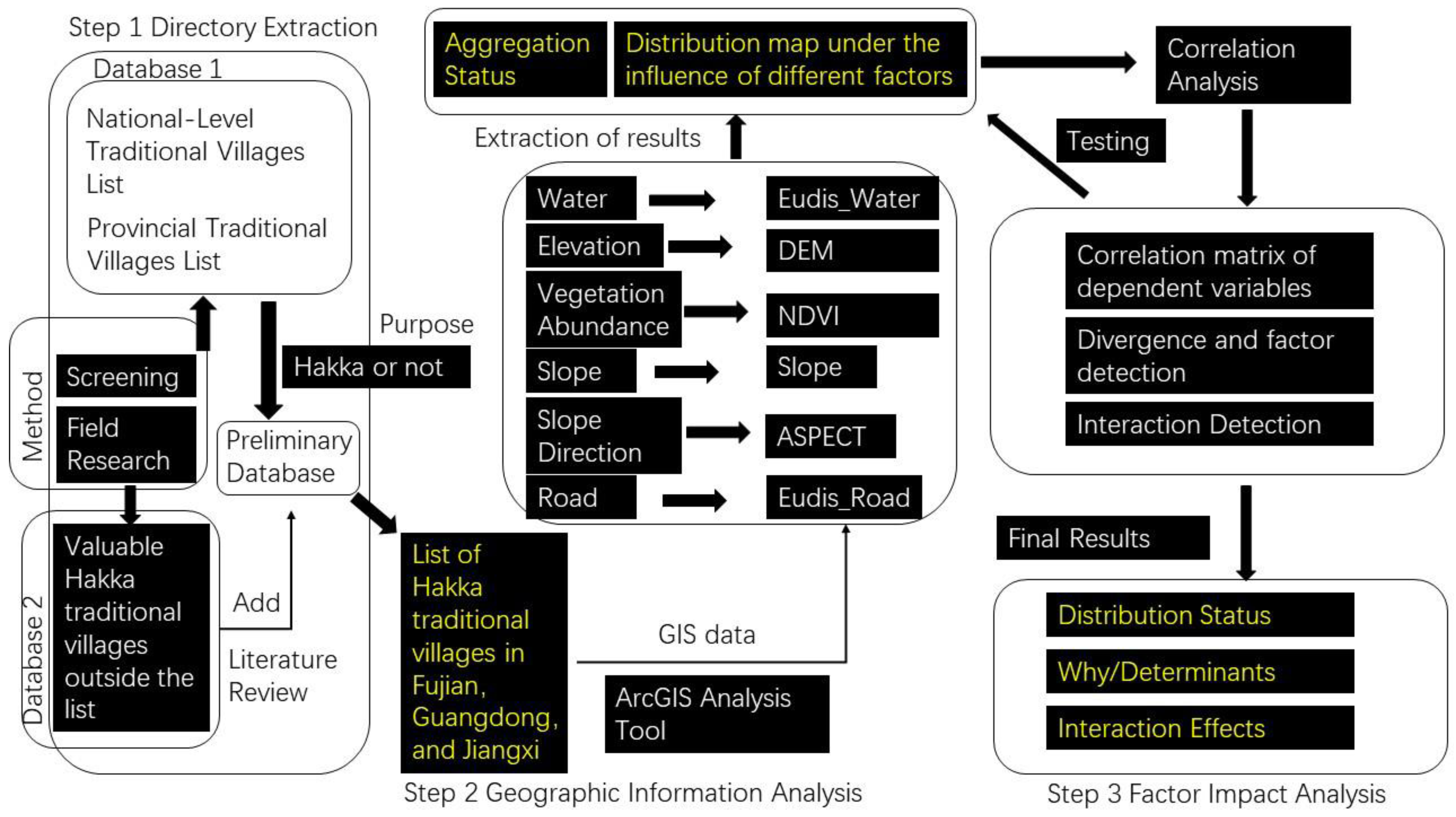
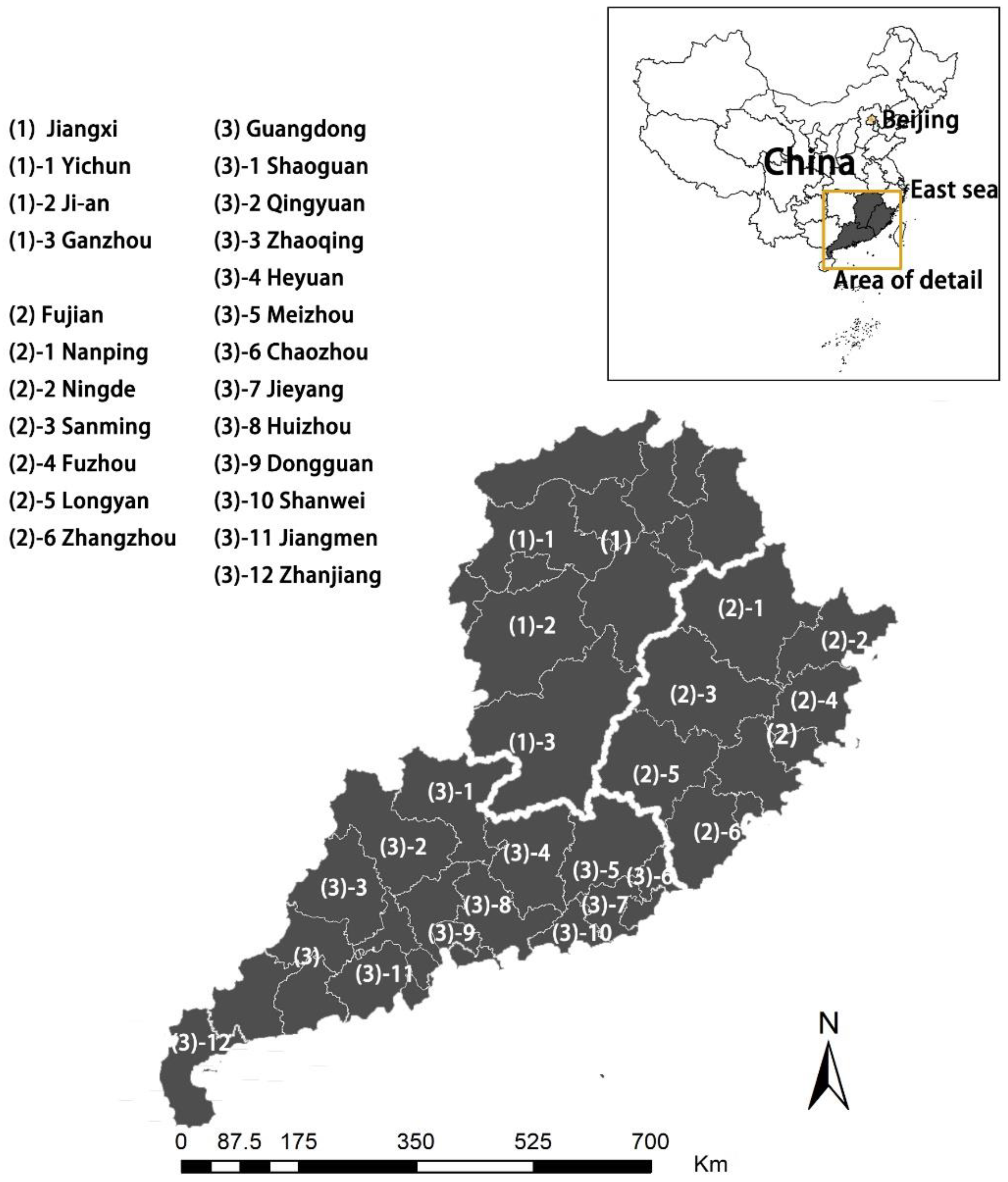
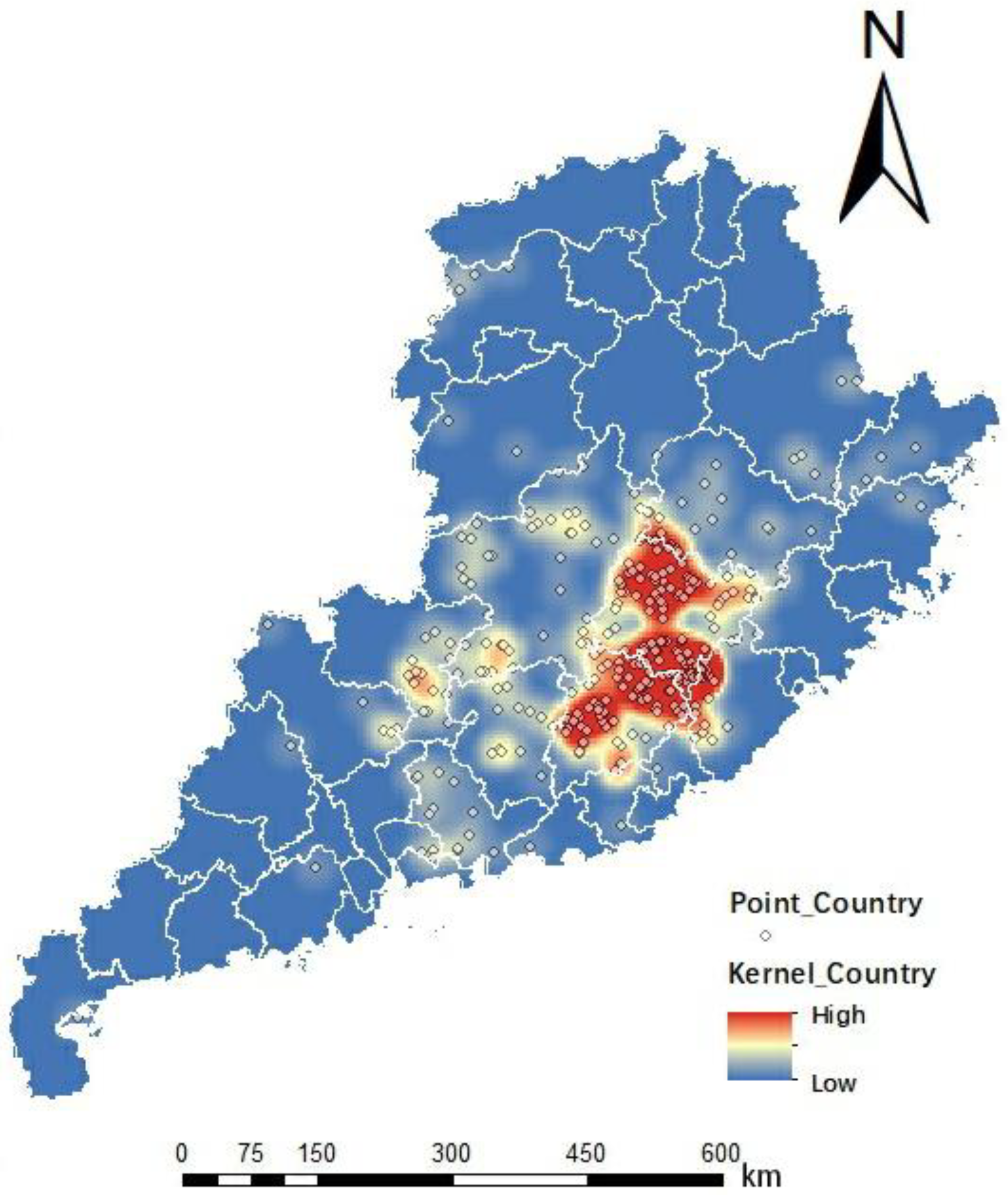
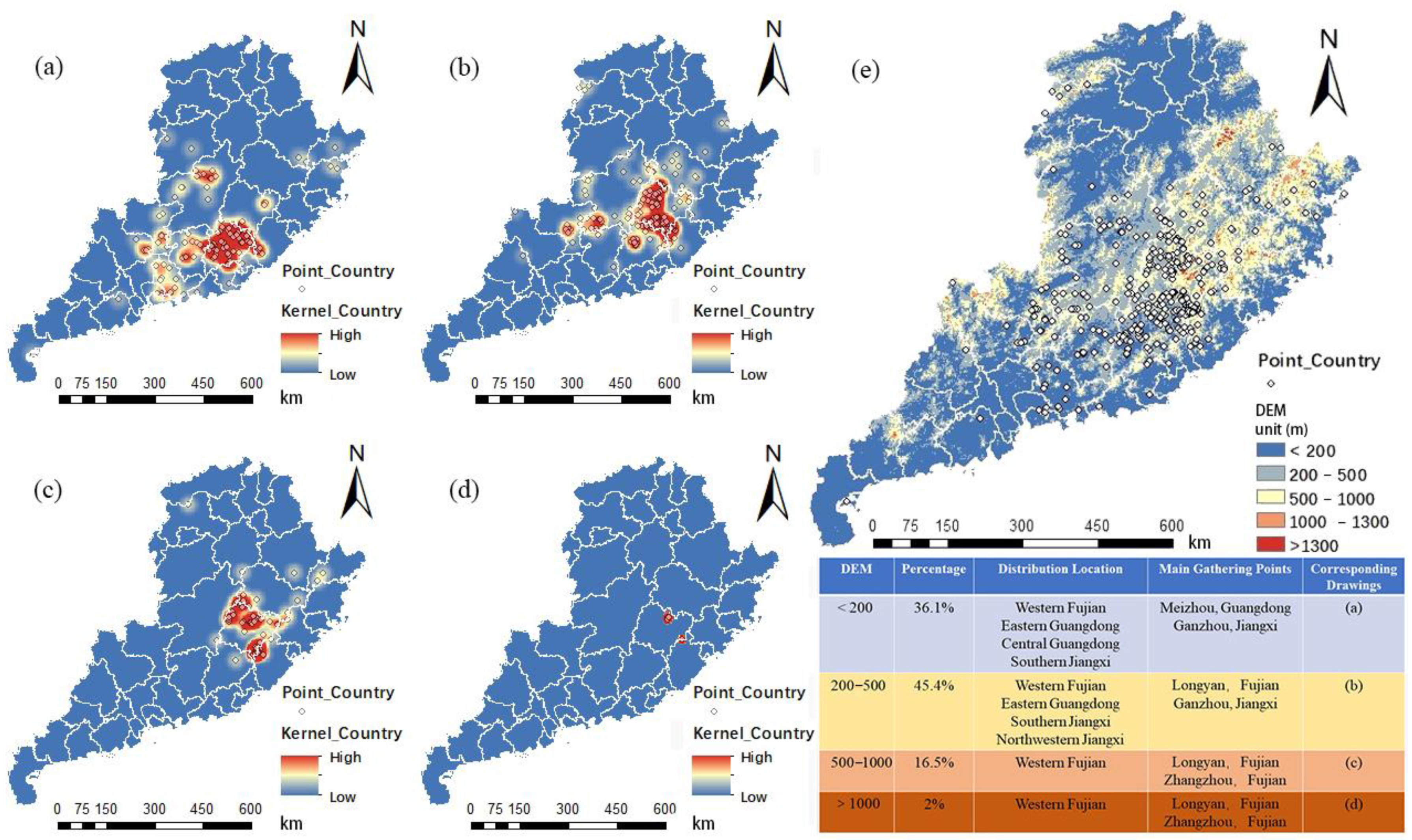
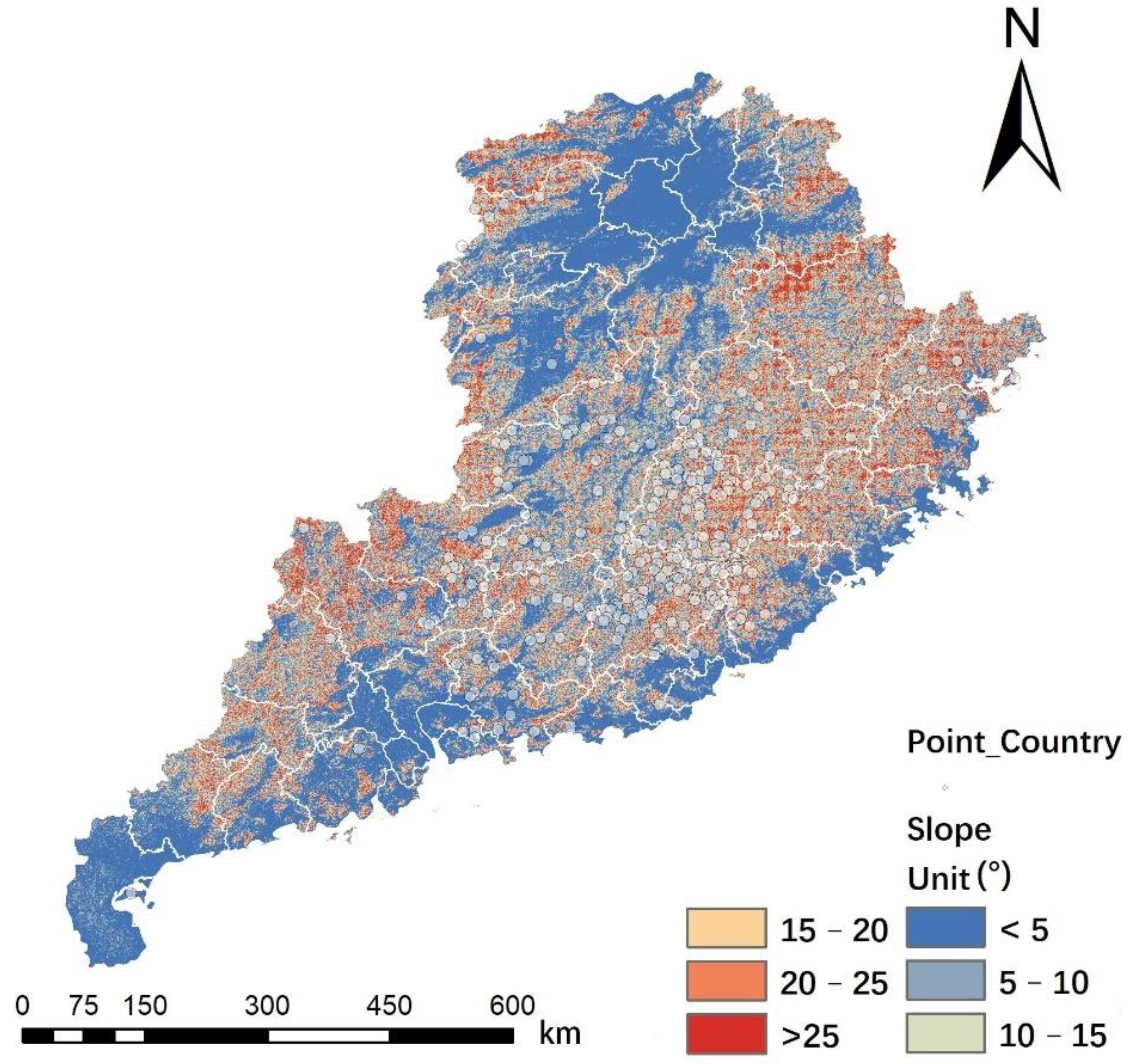
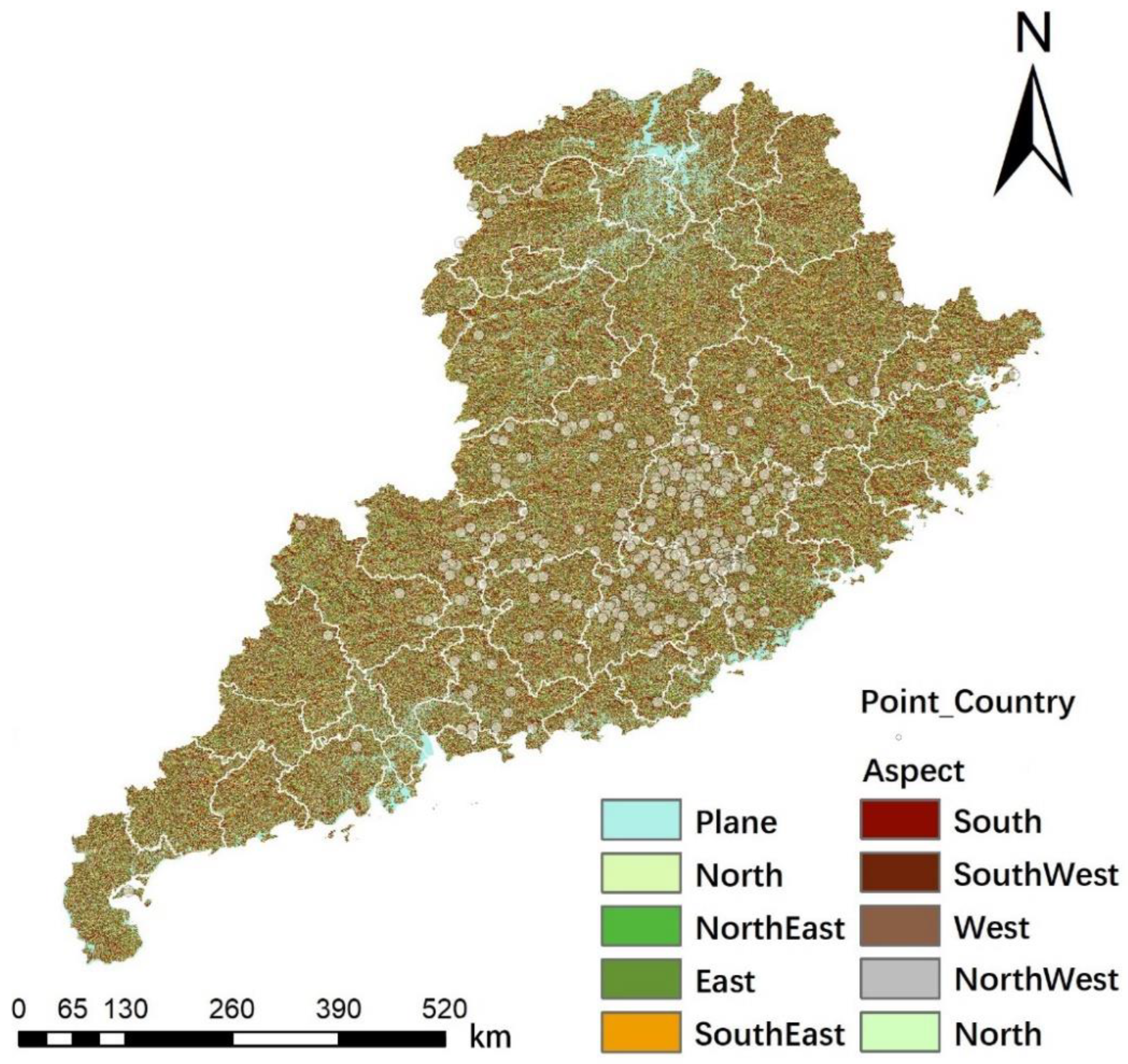
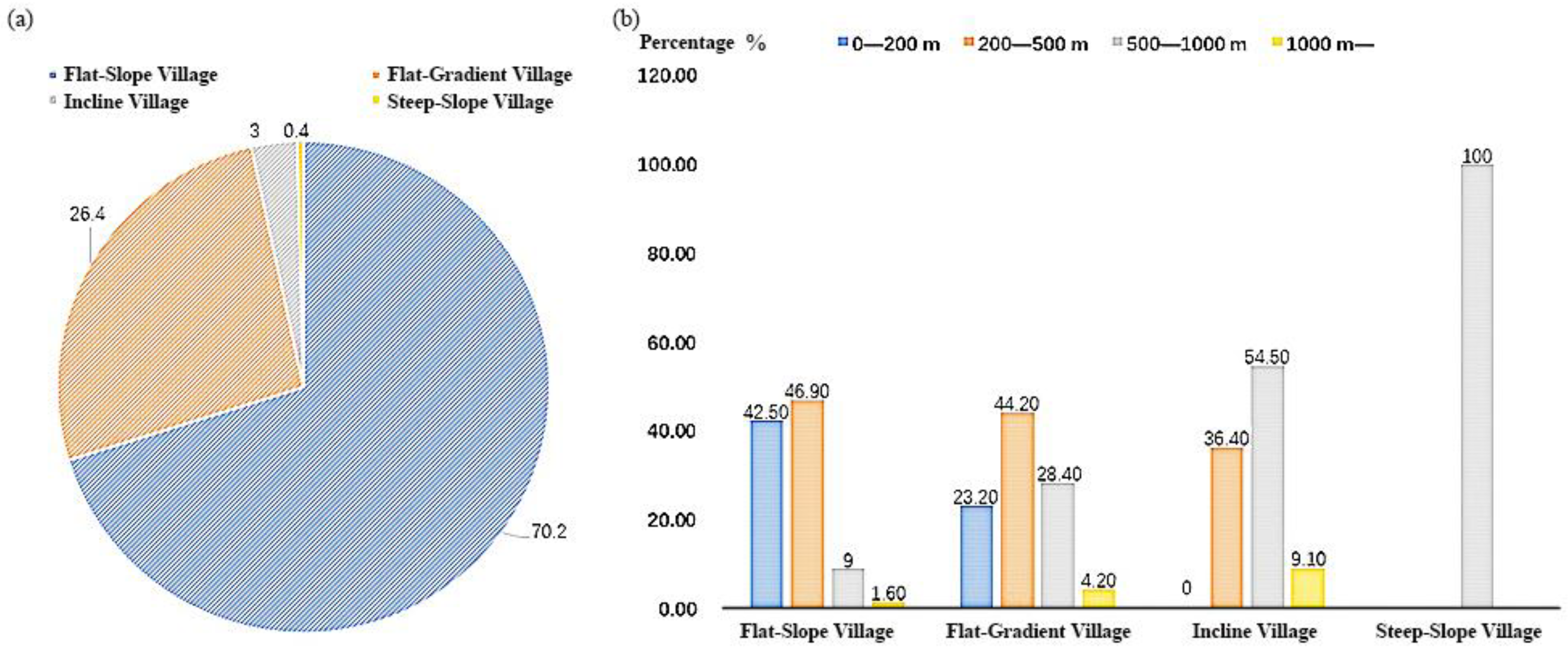

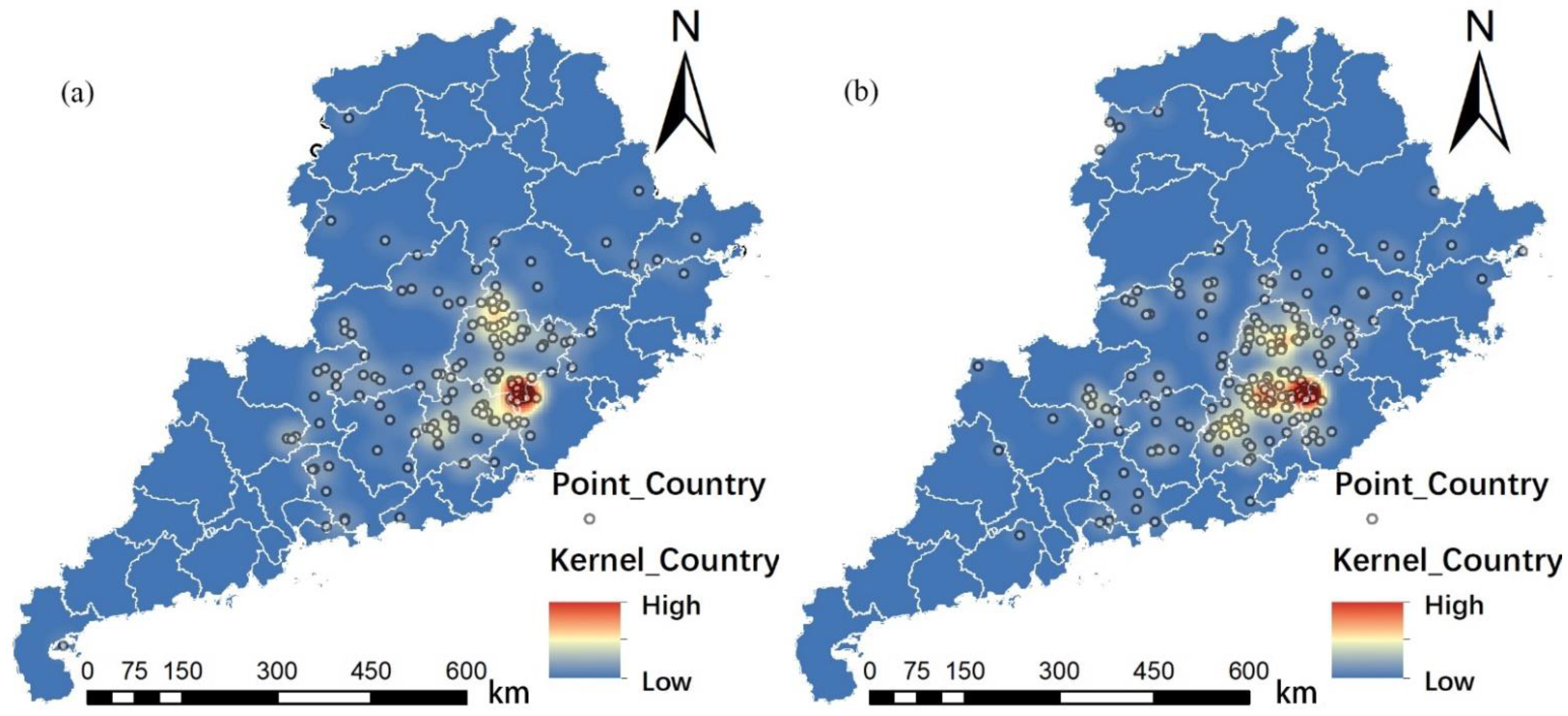
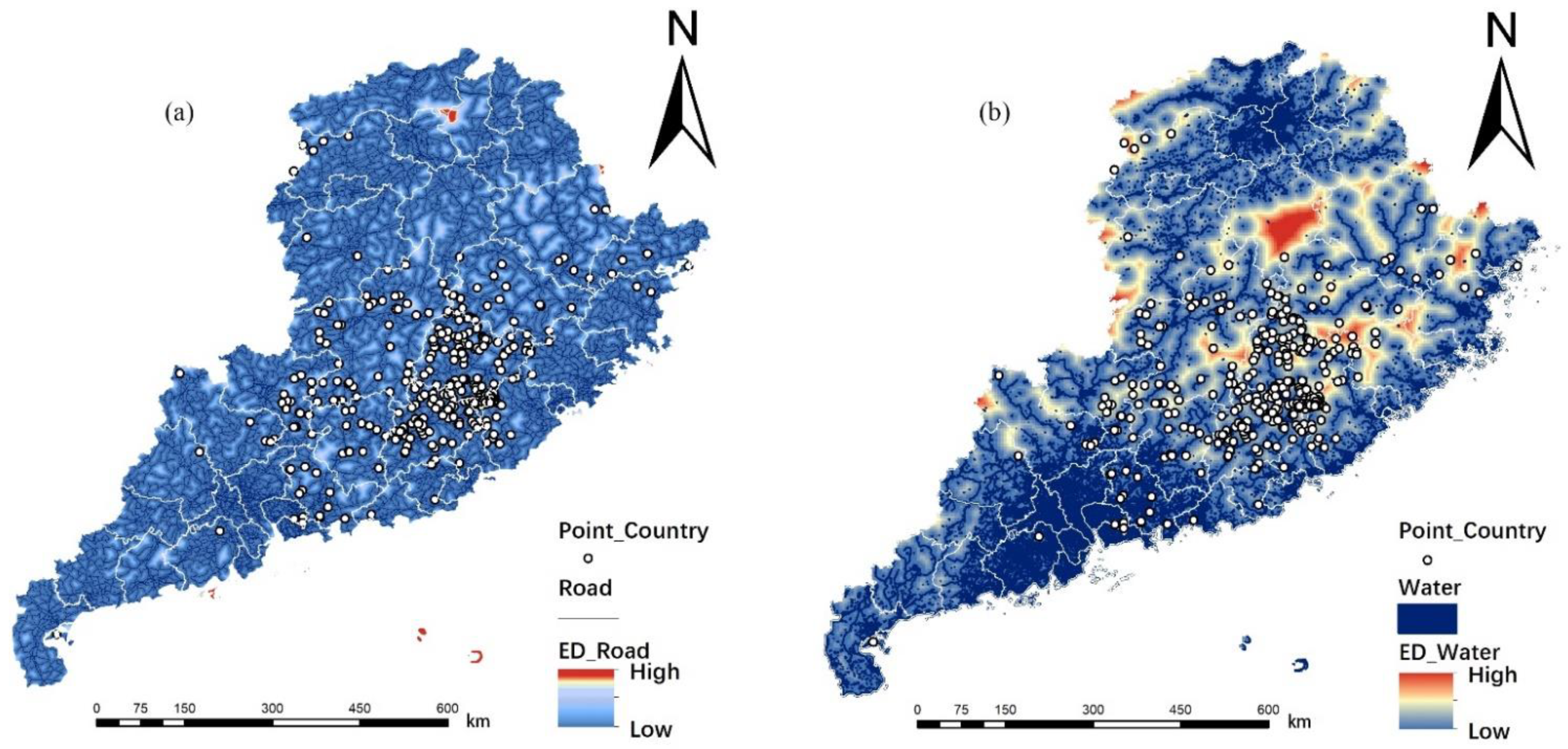



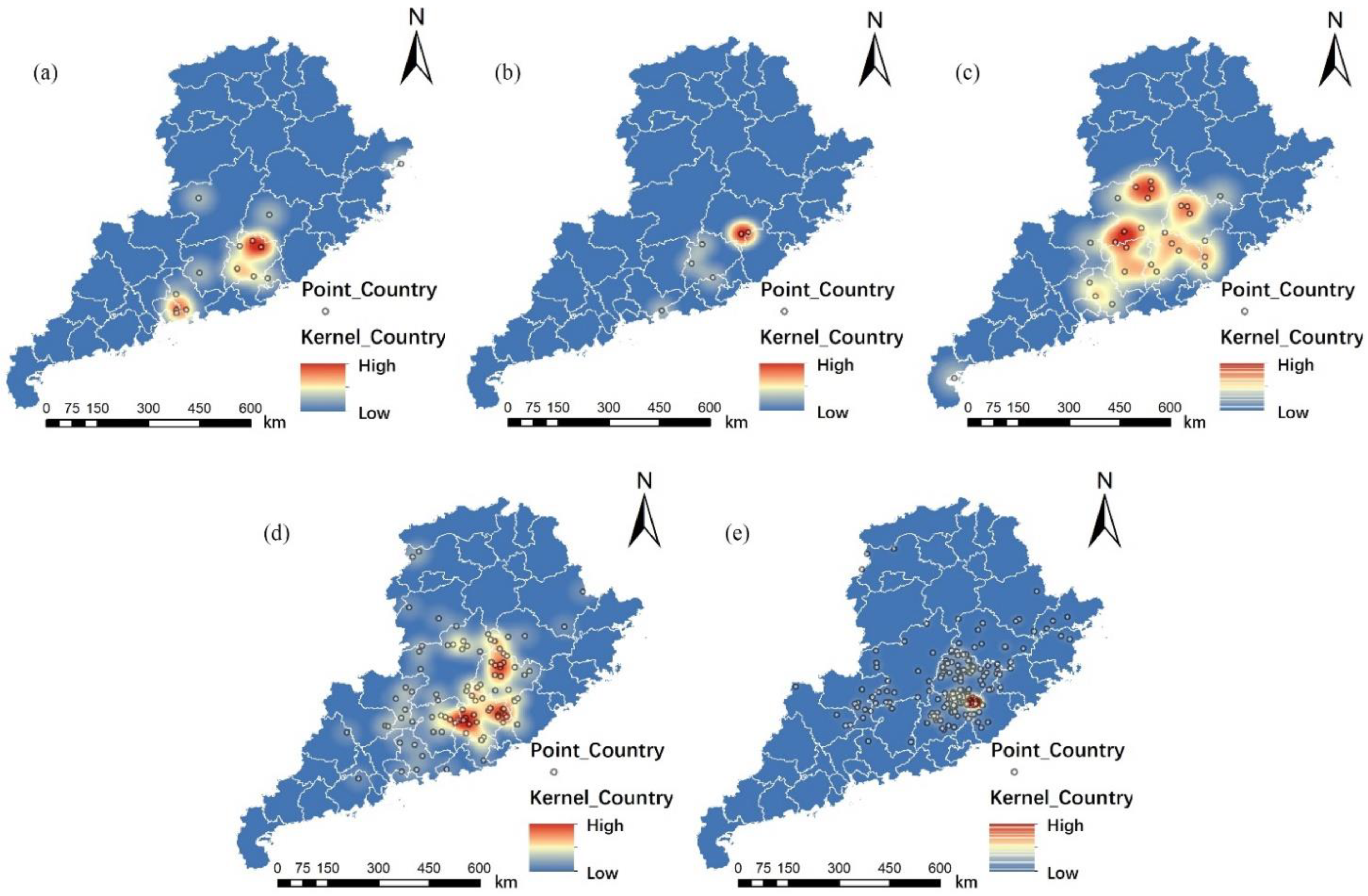
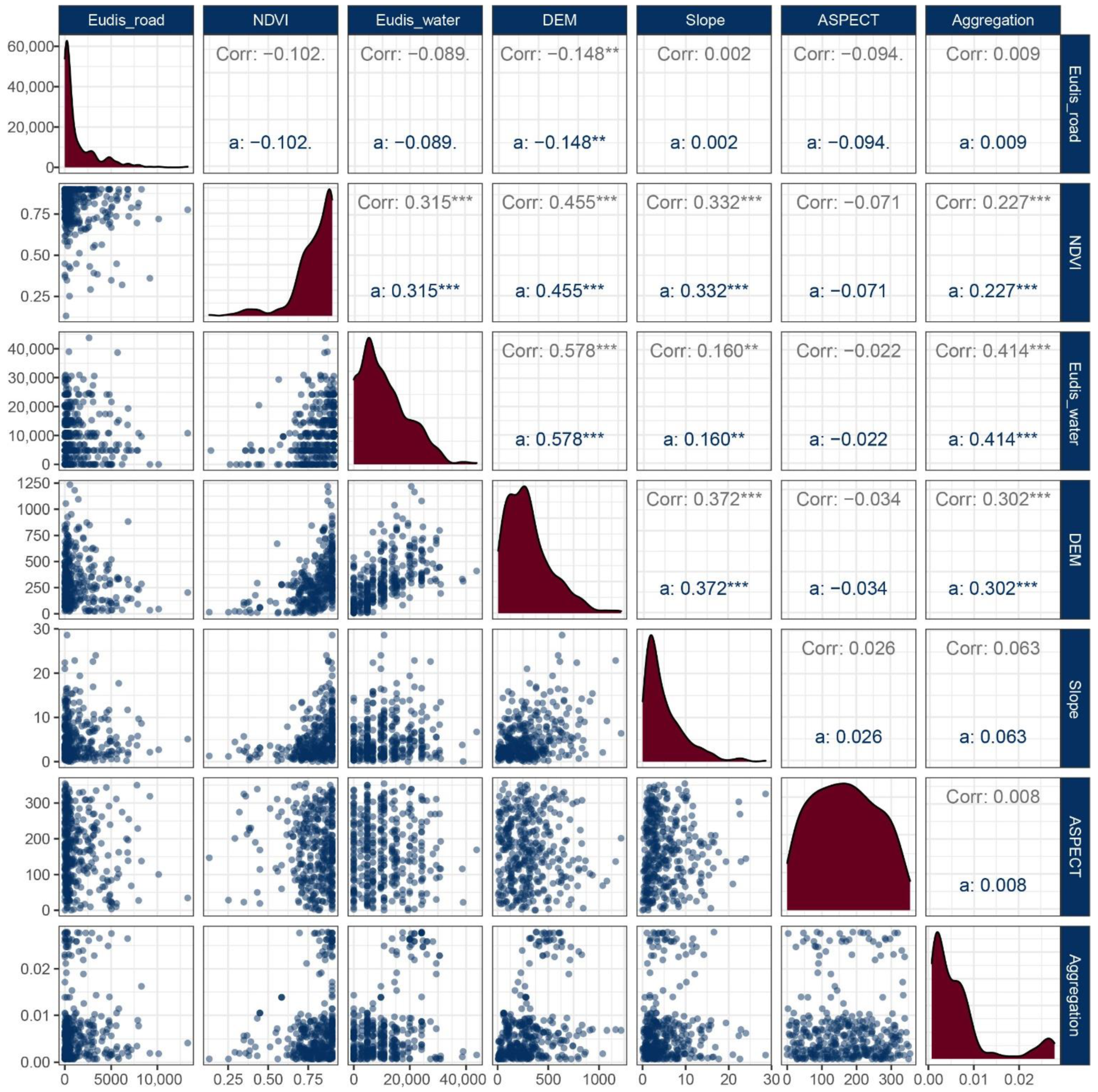
| Eudis_Water | NDVI | DEM | Eudis_Road | Slope | ASPECT | |
|---|---|---|---|---|---|---|
| q statistic | 0.130694 | 0.073316 | 0.11340409 | 0.008835976 | 0.008429762 | 0.003667296 |
| p value | 0.000 | 0.000 | 0.000 | 0.271299 | 0.4618416 | 0.5276866 |
| Eudis_Road | NDVI | DEM | Slope | ASPECT | Eudis_Water | |
|---|---|---|---|---|---|---|
| Eudis_Road | 0.008836 | |||||
| NDVI | 0.099535 | 0.073316 | ||||
| DEM | 0.131147 | 0.182453 | 0.113404 | |||
| Slope | 0.042188 | 0.084577 | 0.153753 | 0.00843 | ||
| ASPECT | 0.016107 | 0.085304 | 0.123852 | 0.016642 | 0.003667 | |
| Eudis_Water | 0.160298 | 0.175133 | 0.187878 | 0.159808 | 0.145939 | 0.130694 |
| Number | Dominant Interaction Factor | q Value | Interaction Results |
|---|---|---|---|
| 1 | Eudis_Road∩NDVI | 0.099535 | Non-linear enhancement |
| 2 | Eudis_Road∩DEM | 0.131147 | Non-linear enhancement |
| 3 | Eudis_Road∩Slope | 0.042188 | Non-linear enhancement |
| 4 | Eudis_Road∩ASPECT | 0.016107 | Two-factor enhancement |
| 5 | Eudis_Road∩Eudis_Water | 0.160298 | Non-linear enhancement |
| 6 | NDVI∩DEM | 0.182453 | Two-factor enhancement |
| 7 | NDVI∩Slope | 0.084577 | Two-factor enhancement |
| 8 | NDVI∩ASPECT | 0.085304 | Non-linear enhancement |
| 9 | NDVI∩Eudis_Water | 0.175133 | Two-factor enhancement |
| 10 | DEM∩Slope | 0.153753 | Non-linear enhancement |
| 11 | DEM∩ASPECT | 0.123852 | Non-linear enhancement |
| 12 | DEM∩Eudis_Water | 0.187878 | Two-factor enhancement |
| 13 | Slope∩ASPECT | 0.016642 | Two-factor enhancement |
| 14 | Slope∩Eudis_Water | 0.159808 | Non-linear enhancement |
| 15 | ASPECT∩Eudis_Water | 0.145939 | Non-linear enhancement |
Publisher’s Note: MDPI stays neutral with regard to jurisdictional claims in published maps and institutional affiliations. |
© 2022 by the authors. Licensee MDPI, Basel, Switzerland. This article is an open access article distributed under the terms and conditions of the Creative Commons Attribution (CC BY) license (https://creativecommons.org/licenses/by/4.0/).
Share and Cite
Xie, G.; Zhou, Y.; Liu, C. Spatial Distribution Characteristics and Influencing Factors of Hakka Traditional Villages in Fujian, Guangdong, and Jiangxi, China. Sustainability 2022, 14, 12068. https://doi.org/10.3390/su141912068
Xie G, Zhou Y, Liu C. Spatial Distribution Characteristics and Influencing Factors of Hakka Traditional Villages in Fujian, Guangdong, and Jiangxi, China. Sustainability. 2022; 14(19):12068. https://doi.org/10.3390/su141912068
Chicago/Turabian StyleXie, Guanhong, Yuchen Zhou, and Chunqing Liu. 2022. "Spatial Distribution Characteristics and Influencing Factors of Hakka Traditional Villages in Fujian, Guangdong, and Jiangxi, China" Sustainability 14, no. 19: 12068. https://doi.org/10.3390/su141912068
APA StyleXie, G., Zhou, Y., & Liu, C. (2022). Spatial Distribution Characteristics and Influencing Factors of Hakka Traditional Villages in Fujian, Guangdong, and Jiangxi, China. Sustainability, 14(19), 12068. https://doi.org/10.3390/su141912068






